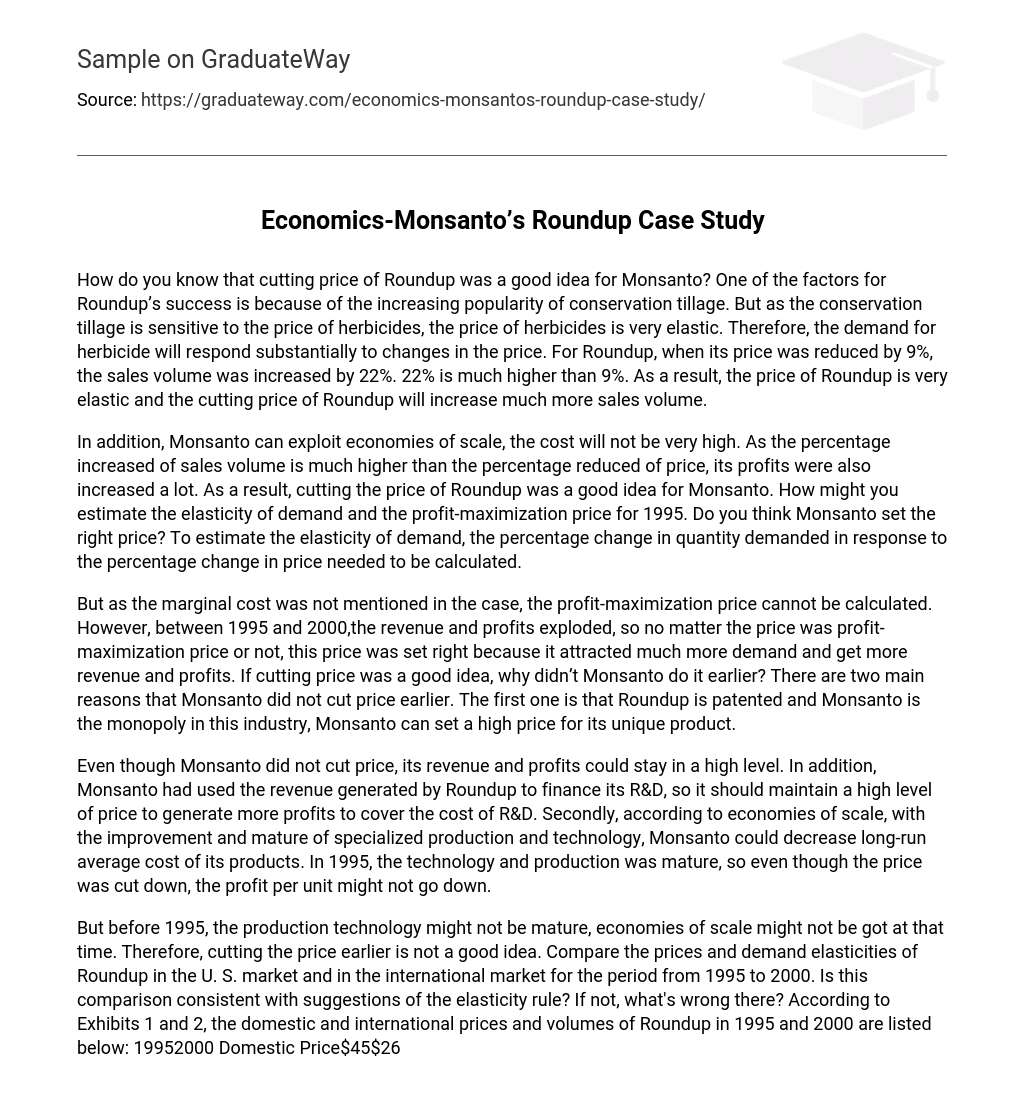How do you know that cutting price of Roundup was a good idea for Monsanto? One of the factors for Roundup’s success is because of the increasing popularity of conservation tillage. But as the conservation tillage is sensitive to the price of herbicides, the price of herbicides is very elastic. Therefore, the demand for herbicide will respond substantially to changes in the price. For Roundup, when its price was reduced by 9%, the sales volume was increased by 22%. 22% is much higher than 9%. As a result, the price of Roundup is very elastic and the cutting price of Roundup will increase much more sales volume.
In addition, Monsanto can exploit economies of scale, the cost will not be very high. As the percentage increased of sales volume is much higher than the percentage reduced of price, its profits were also increased a lot. As a result, cutting the price of Roundup was a good idea for Monsanto. How might you estimate the elasticity of demand and the profit-maximization price for 1995. Do you think Monsanto set the right price? To estimate the elasticity of demand, the percentage change in quantity demanded in response to the percentage change in price needed to be calculated.
But as the marginal cost was not mentioned in the case, the profit-maximization price cannot be calculated. However, between 1995 and 2000,the revenue and profits exploded, so no matter the price was profit-maximization price or not, this price was set right because it attracted much more demand and get more revenue and profits. If cutting price was a good idea, why didn’t Monsanto do it earlier? There are two main reasons that Monsanto did not cut price earlier. The first one is that Roundup is patented and Monsanto is the monopoly in this industry, Monsanto can set a high price for its unique product.
Even though Monsanto did not cut price, its revenue and profits could stay in a high level. In addition, Monsanto had used the revenue generated by Roundup to finance its R&D, so it should maintain a high level of price to generate more profits to cover the cost of R&D. Secondly, according to economies of scale, with the improvement and mature of specialized production and technology, Monsanto could decrease long-run average cost of its products. In 1995, the technology and production was mature, so even though the price was cut down, the profit per unit might not go down.
But before 1995, the production technology might not be mature, economies of scale might not be got at that time. Therefore, cutting the price earlier is not a good idea. Compare the prices and demand elasticities of Roundup in the U. S. market and in the international market for the period from 1995 to 2000. Is this comparison consistent with suggestions of the elasticity rule? If not, what’s wrong there? According to Exhibits 1 and 2, the domestic and international prices and volumes of Roundup in 1995 and 2000 are listed below: 19952000 Domestic Price$45$26
As the international elasticity is larger than that of domestic, the international demand is more elastic. Besides, according to the case, the patent of Roundup was expired in other countries except for US before 1995, many companies in other counties might have the chance to duplicate Roundup, thus making many substitutes in the international markets.
So it is general that the international demand is more elastic than that of domestic. According to the suggestions of the elasticity rule, if the price decreases a little bit, the demand increases a lot with a much larger degree, then the demand is more elastic. So after comparing the prices and demand elasticity of Roundup in the US market and international market, the result is consistent with the suggestions of the elasticity rule.
Monsanto was able to keep itself as a dominant firm in the herbicides market even after Roundup’s patent expired. How would Monsanto achieve this? Firstly, before the Roundup’s patent was expired, Monsanto had kept itself as a dominant firm for many years, so Monsanto had built up strong brand recognition in this industry. Even though other companies can product same herbicides after patent expired, some original customers would choose the brand that they have used.
Secondly, Monsanto has implemented the price cutting strategy for a few years, which has attracted certain amount of loyal customers. When the difference of the prices between other companies and Monsanto, many customers are willing to buy products from Monsanto as Monsanto is the inventor of Roundup. Thirdly, Monsanto has developed herbicide-tolerant crops, naming the Roundup Ready corn. This seeds were complementary products of Roundup. Therefore, when customers wanted to consume Roundup Ready corn, they still needed to consume Roundup herbicide.





